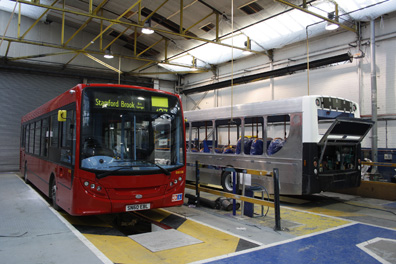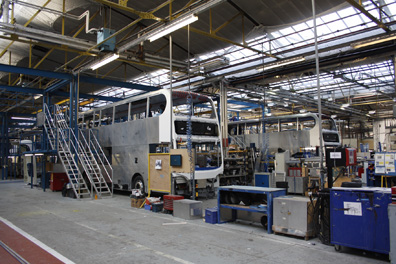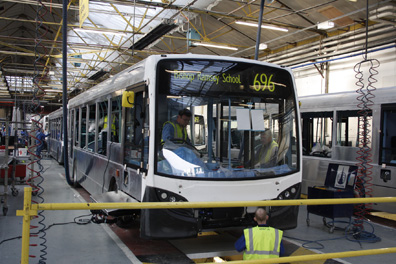
By Doug Jack

Alexander Dennis (ADL), the largest bus builder in the United Kingdom, now has its eyes set on creating new sectors in markets with product gaps and opportunities, and need for shorter, genuine buses that offer reliability, durability and longevity. Chief Executive Colin Robertson believes North America could be such a target.
He has held senior executive positions in the construction equipment industry with Terex, based in Connecticut. Robertson returned to his native Scotland in April 2007 to take the helm at Alexander Dennis. He has made significant progress steering the business profitably through a difficult downturn in the British market last year. He says forecasts for this year are looking better, but exports also cushioned the company.
ADL has for many years exported to Hong Kong and more recently to North America. Robertson wants to reduce the risks of dependency on the British market by further developing export strategies and opening up new markets. Continental Europe is also in his sights, where a lot of preparatory work is going on behind the scenes.
ADL has three main activities. Dennis builds chassis in a factory in Guildford, to the west of London. Alexander is an old-established builder of bus bodywork, located in Falkirk, Scotland. The third arm is Plaxton, based in Scarborough in northeast England, the only remaining builder of luxury coachwork in the UK. However, it also builds midi buses to Alexander designs.

Robertson is very aware that five major groups dominate the British market that normally account for around 70 percent of annual new bus sales. The decision by any one of them to cut back on fleet renewal in any year has an impact on manufacturing. Other factors can also affect sales, such as the introduction of emissions legislation, which inevitably drives up prices and causes cyclical purchasing.
It is probably fair to say as a volume producer, quantity rather than quality was the driving principle at the Alexander factory. The large British bus companies drove hard bargains on prices and specifications. The vehicles were always structurally sound, but some of the interior components were not world class.
Reflecting on his first year at ADL, Robertson was probably only half joking when he told me he had become fed up going to visit customers wearing a flak jacket and hard hat.
“We had to change the whole culture in the factory,” he says. “We had good control over man hours and material flow — we still do — but we knew that we had to improve some components, as well as our inspection and test procedures.”
Fit into a building just over 50 years old, the company has completely modernized the production process, investing in a cleaner workspace with the latest equipment. Assembly follows in a U-shaped flow with parallel lines for assembly of the bolted aluminum structures. The buses then pass through modern paint booths before returning in the opposite direction down the finishing lines.
Upon completion, every bus enters a cabin for a drenching in highly pressurized water to show up any leaks, and driven over a section of rough paving to show up any loose component. One result of this testing has been the introduction of more durable electrical connections.

The company also has invested heavily in product support, empowering its staff to put the customer first. ADL has a team of mobile service engineers for customers suffering a problem. An engineer will arrive with his diagnostic equipment and stay with the vehicle until it is ready to go back into service.
ADL is the largest producer of hybrid buses in Europe. After some early trials, the company teamed with BAE Systems to supply the series hybrid drive systems. By the end of 2011 more than 350 units will be in service in the United Kingdom. Most are double-deck buses for London and other cities around the country, with some single deck midi-buses.
Double-decks a speciality
Double-deck buses and midi buses are Alexander Dennis specialties, and Robertson is very keen on the concept. The company has supplied double decks in large quantity over many years to Hong Kong, as well as North America. They run in Vancouver, Toronto, New York, Washington D.C., Las Vegas, San Francisco and Seattle. Working with ElDorado at its assembly facility in Riverside, CA enabled ADL to supply double-deck buses that comply with Buy America regulations.
“We would like to sell more in North America and as part of that process we will introduce a stylish new look for our three-axle Enviro 500 later this year,” says Robertson. “Look at any city, the problem is apparent — space, or rather the lack of it. A 40-foot double-deck bus has the same footprint as a conventional single deck bus and takes up the same amount of space as two or three cars, but can carry upwards of 80 people on comfortable seats.”
He says the real issue is about winning back the space in a way that passengers enjoy, while also introducing a real incremental revenue earner.
“Double-deck buses offer a multiple solution,” says Robertson. “They have increased passenger ridership and revenue everywhere in North America they have been introduced.”
ADL also is Europe’s leading builder of midi buses by a long way with almost 16,000 sold to date. Twenty years ago the first units were about 28-foot long with a Cummins engine mounted in line at the rear and driving through an Allison fully automatic gearbox to the rear axle. The passenger entrance was ahead of the front axle, directly under the supervision of the driver. The short wheelbase meant that they were highly maneuverable.
Designed for a 10-year life cycle with their robust structures, many lasted much longer. They were inexpensive to buy and maintain, and often used on routes with insufficient numbers of passengers to justify full size heavy-duty, single-deck buses. Others helped to improve the frequency of services, for instance running every 10 minutes to replace a large bus that ran every 15 minutes.
ADL has developed steadily up to the present Enviro200, offering a full range of stylish and popular midi buses from 29 to 37 feet, with seating layouts from 20 to 41 feet. A 53-degree steering lock angle contributes to their maneuverbility and excellent turning radius. The floor ahead of the rear axle is only one step above the ground. Because the wheels and tires are smaller entry and exit is very easy. Cummins has introduced compact but powerful 4-cylinder engines which fit neatly under the rearmost row of seats.
In North America, ADL had supplied some of the previous ALX200 Dart midi-buses through Thomas Built Buses, while in its pre-ADL days, Plaxton sold some Dart chassis with Pointer bodywork to Canada.
“Our latest Enviro200 buses offer real value for money, and performance,” says Robertson. “They have a track record and provenance second to none. Equally important, the time is right for a new range of vehicles that have big bus characteristics and life cycles that extend comfortably to 12 to 15 years. Also, with oil around $100 a barrel, fuel economy and efficiency have become a much higher priority.”
The Enviro200 fits in between cutaways and full size buses, with the benefits of very easy accessibility and maneuverability. With a Cummins Allison driveline, the Enviro200 will go straight into any North American fleet. Another advantage is the aluminum structure, which is light weight, totally resistant to corrosion and fully recyclable.
ADL now has an annual turnover approaching $500 million. It is in an interesting position, being small enough to respond quickly to market demand but large enough to benefit from economies of scale. Robertson is determined to develop export sales, with North America being a prime target, noting its strong national ties and common language as tremendous benefits.
Doug Jack is with Transport Resources in the United Kingdom.
